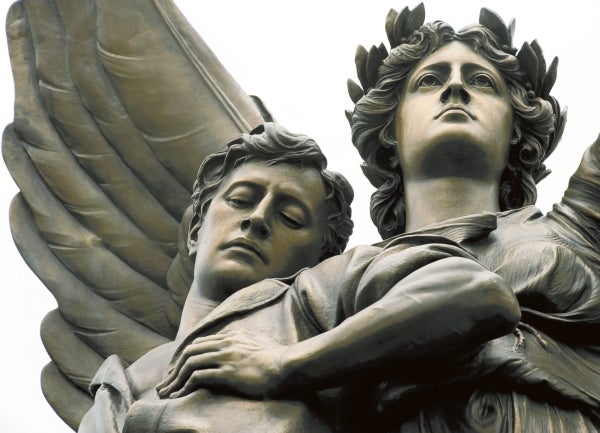What does future hold for Salisbury’s Confederate monument?
Published 12:00 am Thursday, August 17, 2017

- The Confederate statue of ‘Fame.'
SALISBURY — Numerous events have happened in recent days to create a snowball rolling down the hill toward Salisbury. It’s headed directly for the Confederate monument.
These events have happened in Raleigh, Durham, Charlottesville, Virginia, and Baltimore. Actually, they’ve been occurring lately across the South, and they all suggest the inevitability that Salisbury’s grouping of the allegorical “Fame” or “Glory” and the dying soldier she holds will have to be taken down, moved or somehow rededicated or repurposed.
The question now seems to be, can the community be proactive in discussing and deciding the monument’s fate before this snowball hits too hard?
A bronze statue should not be the reason for any more deaths. It should not serve as a rallying spot for divisiveness, racism and hatred. Neither should it be vandalized or pulled down in a heap and spit upon.
All of these things could happen. It will take much resolve, negotiation and courage to make sure they don’t.
Tuesday, Gov. Roy Cooper said Confederate monuments around the state should come down or be moved elsewhere. Georgia, Virginia and North Carolina each have 90 or more Confederate monuments.
“We cannot continue to glorify a war against the United States of America fought in the defense of slavery,” Cooper said. “These monuments should come down.”
First, the General Assembly will have to repeal a 2015 law prohibiting the removal of the monuments without legislative approval.
Cooper’s stand followed the toppling of a Confederate statue Monday night in Durham. A crowd cheered as demonstrators on the ground used a rope to yank down the 1924 bronze statue of a Confederate soldier.
That incident came in the aftermath of Saturday’s violence at a Charlottesville rally, organized by white supremacists who were protesting the removal of a Gen. Robert E. Lee statue from a downtown park.
A 32-year-old woman was killed when a young man plowed his car into demonstrators against the rally.
In the dark of night Tuesday, the city of Baltimore removed four Confederate monuments from their bases, including “Gloria Victis” on Mount Royal Avenue.
That statue is a twin to the “Gloria Victis” monument in Salisbury. The only difference is the soldier in the Maryland statue holds a battle flag, while the soldier in Salisbury carries a rifle.
Noted sculptor F. Wellington Ruckstuhl did both the Maryland and Salisbury groupings. Baltimore’s “Gloria Victis” (which translates to “Glory to the Vanquished”) was erected in 1903 by the Maryland Daughters of the Confederacy, and it had been vandalized in the recent past.
The Robert F. Hoke Chapter of the United Daughters of the Confederacy paid for the Salisbury monument, dedicated at Confederate Memorial Day on May 10, 1909.
The four different Confederate monuments in Baltimore were loaded onto flatbed trucks between 11:30 p.m. Tuesday and 5:30 a.m. Wednesday. The Baltimore Sun reported it was “an abrupt end to more than a year of indecision on what to do with the memorials.”
The Baltimore City Council had passed a resolution earlier in the week calling for the monuments to be removed, and the mayor wasted no time in following through.
I recognize how emotional and controversial the Confederate statue’s departure from the median at West Innes and Church streets would be. I personally have argued in the past that the 108-year-old grouping should stay where it is out of its historical, memorial and educational value and what it represents as a magnificent example of public art.
But these have to be feeble arguments to any African-American who walks or drives by that monument daily and sees it as glorifying and celebrating a Confederacy of States dedicated to keeping their ancestors in bondage.
I know many people in 2017 — black and white — probably don’t think of the statue in those terms. They see it more as a beautiful “angel” taking a wounded soldier to heaven, and what could be wrong with that?
But it’s difficult to get beyond the inscription on the base of Salisbury’s monument, which says “Deo Vindice,” the motto of the Confederate States of America.
I have seen this motto translated in different ways, most frequently as “With God as our champion” or ” With God as our vindicator.” Inherent in those words is the belief that the Confederate cause was just, when it clearly was not just to enslaved African-Americans.
The Salisbury monument brings with it a lot of complicated issues to be sorted out, such as the UDC’s ownership and who actually controls the land or right of way on which the monument stands. The UDC? The city? The N.C. Department of Transportation?
If the monument is taken down and moved, where does it go? A cemetery? A park? A museum? In a time capsule? Could it be rededicated to reflect its history but encompass a much more inclusive message or symbolism? That would be difficult to accomplish, but maybe it’s possible.
I just know this: I don’t want to see the statue used as an excuse for hatred and violence. I don’t want it to be a symbol of divisiveness. I don’t want to see it vandalized and destroyed.
It’s time to get out in front of this now, before the snowball becomes an avalanche.
Contact Mark Wineka at 704-797-4263, or mark.wineka@salisburypost.com.



